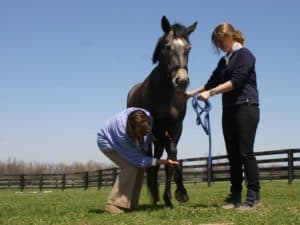Weed Management in Pastures, Hayfields, and More
Weeds can reduce the quantity and the stand life of desirable forage plants in pastures and hayfields. These unwanted plants are often more aggressive than existing or desired forage species and compete for light, water, and nutrients. Weeds can also diminish the quality and palatability of the forage available for livestock grazing, and certain weed species are potentially poisonous to grazing animals. Additionally, weeds impact a pasture’s aesthetic value.
Therefore, property owners might want to initiate weed management strategies that reduce weeds’ impact on forage production. However, not all weedy plants are detrimental to pastures or hayfields. In fact, some weedy plants provide nutritional value to grazing animals; thus, owners should make prudent management decisions to determine when or if they should initiate weed control in a pasture or hayfield.
Effect of Weeds on Pasture Yield and Animal Performance
In general, weedy plants are usually not high yielding and are considered to be low in quality. However, livestock often eat many weeds along with the desired forage grasses and legumes. In fact, the dry matter digestibility of several weed species during their early vegetative stage of growth is generally high and comparable to seeded forage species. Crude protein levels are also adequate for consumption by cattle. But, like many cultivated forage grasses, digestibility and crude protein decline as weeds mature. Thus, the greatest benefits in digestibility and crude protein are obtained from weeds and desirable forage species that are grazed during their early growth stages.
On the other hand, some weedy plants are unpalatable compared with the desirable forage species; thus, animals do not normally consume them. For example, livestock selectively graze weeds such as curly dock and tall ironweed to a greater extent than more palatable species such as crabgrass.
Poisonous Plants
One consideration before allowing livestock to graze weed-infested fields is the potential for exposure to poisonous plants. The potential for livestock poisonings depends on the poisonous plant’s availability and quantity, the stage of plant growth, the time of year, and the kind of animal. Most potentially poisonous plants (but not all) must be consumed in large enough quantities to cause animal death. Many plants have an undesirable taste, and animals do not consume them at levels that are toxic unless other forages are limited during periods of drought or long winter seasons. Several potentially toxic plants found in Kentucky are listed in Table 1.

Weed Control Methods
The way you manage your pasture can have a major impact on the presence of weedy plants. Production practices that result in overgrazing and low fertility levels favor weed emergence, propagation, and growth. The ideal approach is to incorporate practices that are more adaptable to the growth of the desirable forage species and less favorable for unwanted plants.
Although there are exceptions, most weeds do not compete well with a dense stand of desirable forage species. To minimize weedy plants’ effects, property owners should manage pastures and hayfields to favor vigorous growth of the desired forage species.
Effective pasture management programs include these practices:
- Maintaining proper soil pH and fertility levels;
- Using controlled grazing practices;
- Mowing at proper timing and stage of maturity;
- Allowing new seedlings to become well-established before use; and
- Renovating pastures when needed.
Herbicides can be another useful tool for managing weed in pastures and hayfields. Use them where appropriate and when cost-effective.
A program that integrates several different control strategies is generally more successful than relying on only one method. Weeds present at the time of herbicide application might be controlled, but if the forage stand is not vigorous and actively growing, new weed seedlings will soon emerge and occupy the remaining bare areas.
Thus, without proper mechanical control methods and good cultural practices, herbicide use will not be beneficial.
To see the entire publication, please visit www2.ca.uky.edu/agc/pubs/agr/agr172/agr172.pdf.


Written by:
University of Kentucky College of Agriculture, Food, and Environment
Related Articles
Stay on top of the most recent Horse Health news with












